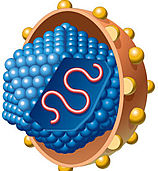HCV
Viral Load Decline at Day 2 of Interferon-based Therapy Predicts Sustained Response,
Explains Poorer Outcomes in African-Americans By
Liz Highleyman  Declines
in hepatitis C virus (HCV) viral load as early as 2 days after starting interferon-based
therapy can help predict which individuals will achieve sustained
virological response (SVR), and may help explain why different racial/ethnic
groups respond differently to treatment, according to a study in the April
15, 2009 Journal of Infectious Diseases. Declines
in hepatitis C virus (HCV) viral load as early as 2 days after starting interferon-based
therapy can help predict which individuals will achieve sustained
virological response (SVR), and may help explain why different racial/ethnic
groups respond differently to treatment, according to a study in the April
15, 2009 Journal of Infectious Diseases.
Past
research has established that people of African descent do not respond as well
as Caucasians to interferon-based therapy
for hepatitis C; people of Asian descent tend
to respond better than other groups, while data are mixed for Latino/Hispanic
patients. The
Virahep-C trial, sponsored by the National Institutes of Health, was designed
to look at factors associated with differences in hepatitis C treatment response,
especially disparities between whites and African-Americans. A
total of 401 previously untreated genotype 1 chronic hepatitis C patients (205
Caucasian, 196 African-American) were treated with 180
mcg/week pegylated interferon alpha-2a (Pegasys) plus 1000-1200 mg daily weight-adjusted
ribavirin, initially for 24 weeks. Those who did not achieve undetectable
HCV RNA at this point stopped therapy, while responders continued treatment for
a total of 48 weeks. In
the present analysis, Jay Hoofnagle from the National Institute of Diabetes and
Digestive and Kidney Diseases (NIDDK) and colleagues assessed early changes in
HCV RNA levels among Virahep-C participants. The analysis was restricted to 341
patients who completed the first 28 days of therapy without dose modification
(the point at which rapid virological response, or RVR, is assessed). Results
 HCV RNA levels decreased in almost all participants, but the amount of decline
varied markedly from patient to patient.
HCV RNA levels decreased in almost all participants, but the amount of decline
varied markedly from patient to patient.
 Differences in HCV RNA decline between whites and African-Americans reached statistical
significance by day 2 of treatment.
Differences in HCV RNA decline between whites and African-Americans reached statistical
significance by day 2 of treatment.
 At day 28, 22% of Caucasians had undetectable HCV RNA compared with 12% of African-Americans.
At day 28, 22% of Caucasians had undetectable HCV RNA compared with 12% of African-Americans.
 The overall decrease in HCV RNA at day 28 predicted SVR at least as well as first-phase
or second-phase viral kinetics.
The overall decrease in HCV RNA at day 28 predicted SVR at least as well as first-phase
or second-phase viral kinetics.
 Factors associated with a smaller decline in HCV RNA from baseline to day 28 included:
Factors associated with a smaller decline in HCV RNA from baseline to day 28 included:
 African-American race;
African-American race;
 Higher initial HCV RNA level;
Higher initial HCV RNA level;
 More severe hepatic fibrosis;
More severe hepatic fibrosis;
 Higher body weight.
Higher body weight.
 African American patients whose 28 day decline in viral load was similar to that
of white patients were still less likely to achieve SVR.
African American patients whose 28 day decline in viral load was similar to that
of white patients were still less likely to achieve SVR.
These
findings led the researchers to suggest that racial differences in response to
standard anti-HCV therapy are likely related to biological -- likely genetic --
differences in how the body responds to interferon.
"The underlying
cause of virological non-response and the reasons why it is more common among
African Americans than Caucasian Americans are not clear," the study authors
wrote. "[T]he current analyses demonstrated that these differences are fundamentally
biologic and become apparent within 24 to 48 hours of starting therapy."
In conclusion, they wrote, "These results suggest that racial differences
in the response to antiviral therapy are due to greater unresponsiveness to intracellular
actions of interferon in African American individuals and that standard doses
of peginterferon and ribavirin may be suboptimal for patients with higher body
weights."
Previously
presented Virahep-C research has looked at associations between racial differences
in treatment response and interferon pharmacokinetics, genetic differences in
interferon signaling, and major histocompatibility genes.
In an editorial
accompanying Hoofnagle's report, Andrew Tai and Raymond Chung from Massachusetts
General Hospital wrote that this analysis "demonstrates that the low rates
of SVR in African American patients in response to interferon-based therapy appear
to result, in large part, from impaired early viral kinetics. Further studies
are necessary to uncover the relevant mechanisms that underlie this defect in
interferon signaling with the hope that such mechanisms can be manipulated to
restore interferon responsiveness in the otherwise nonresponsive host."
If
poorer outcomes among African-Americans are shown to be due to reduced responsiveness
to interferon, differences in treatment response might diminish with the use of
investigational antiviral agents that directly target various stages of the HCV
life cycle rather than modulating immune function. Liver
Disease Research Branch, Division of Digestive Diseases and Nutrition, National
Institute of Diabetes and Digestive and Kidney Diseases, National Institutes of
Health, Bethesda, MD; Division of Hepatology, University of Maryland School of
Medicine, Baltimore, MD; Departments of 3Biostatistics and Epidemiology, Graduate
School of Public Health, University of Pittsburgh, Pittsburgh, PA; Division of
Gastroenterology and Hepatology, New York-Presbyterian Medical Center, New York,
NY.
6/02/09
References JH
Hoofnagle, AS Wahed, RS Brown, and others. Early Changes in Hepatitis C Virus
(HCV) Levels in Response to Peginterferon and Ribavirin Treatment in Patients
with Chronic HCV Genotype 1 Infection. Journal of Infectious Diseases 199(8):1112-1120.
April 15, 2009 AW
Tai and RT Chung. Racial Differences in Response to Interferon?Based Antiviral
Therapy for Hepatitis C Virus Infection: A Hardwiring Issue? Journal of Infectious
Diseases 199(8): 1101-1103. April 15, 2009.
|